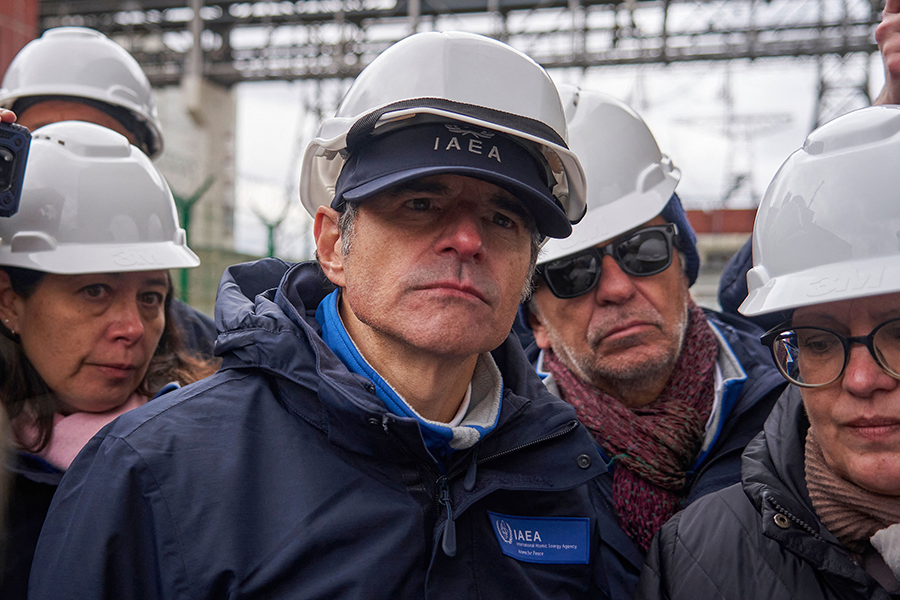"I greatly appreciate your very swift response, and your organization's work in general. It's a terrific source of authoritative information."
IAEA Shifts Priorities for Zaporizhzhia
May 2023
By Kelsey Davenport
After months of negotiations with Russia and Ukraine to establish a protection zone around the Zaporizhzhia Nuclear Power Plant, the head of the International Atomic Energy Agency (IAEA) said he is now focused on reaching a narrower agreement to protect certain areas of the facility that pose a greater risk.
 IAEA Director-General Rafael Mariano Grossi announced the shift in the agency’s priorities after visiting Zaporizhzhia on March 29 and observing the buildup of military forces in the area. In a March 30 statement, the IAEA said Grossi’s proposal evolved from creating a territorial zone around the plant to reaching an agreement on “what should be avoided” at the facility to ensure protection of the six-reactor Zaporizhzhia plant during conflict. Prior to the visit, Grossi told Associated Press in a March 28 interview that negotiations on establishing the zone were being “affected by the ongoing military options.”
IAEA Director-General Rafael Mariano Grossi announced the shift in the agency’s priorities after visiting Zaporizhzhia on March 29 and observing the buildup of military forces in the area. In a March 30 statement, the IAEA said Grossi’s proposal evolved from creating a territorial zone around the plant to reaching an agreement on “what should be avoided” at the facility to ensure protection of the six-reactor Zaporizhzhia plant during conflict. Prior to the visit, Grossi told Associated Press in a March 28 interview that negotiations on establishing the zone were being “affected by the ongoing military options.”
Russia has illegally occupied the Zaporizhzhia plant since February 2022, but the facility is still operated by Ukrainian personnel. (See ACT, April 2022.) Moscow and Kyiv professed support for Grossi’s initial plan to establish a protection zone, but officials on both sides expressed doubt about the feasibility of establishing it. (See ACT, March 2023.)
Grossi emphasized in the March 28 interview that his approach is focused on “a series of principle[s] or commitments [that] everybody would be able to support.” He said that if Russia and Ukraine make a political commitment to protect Zaporizhzhia, it will be an agreement with the IAEA and they “are not agreeing with each other.” He characterized the nature of the agreement as “a very important element” that Russia and Ukraine should take into consideration.
In the March 30 statement, Grossi emphasized the urgency of reaching an agreement. He said it is “obvious that military activity is increasing” in the Zaporizhzhia region and that the “area is facing perhaps a more dangerous phase in terms of the ongoing conflict.” He said it is “very, very important that we agree on the fundamental principle that a nuclear plant should not be attacked.”
Prior to visiting the Zaporizhzhia plant, Grossi met with Ukrainian President Volodymyr Zelenskyy and said on March 27 that they had a “rich exchange” regarding the protection of the facility and its staff. Grossi said his trip was also focused on ensuring that IAEA personnel stationed at the facility since September can rotate in on a regular basis after a delay in February prevented a new agency team from entering the facility for nearly a month.
 Following his visit, Grossi met on April 5 in Kaliningrad with Russian officials, including Alexey Likhachev, director-general of the Russian nuclear energy company Rosatom. Although Ukrainian staff still run the Zaporizhzhia plant, Rosatom has stationed some of its personnel at the facility.
Following his visit, Grossi met on April 5 in Kaliningrad with Russian officials, including Alexey Likhachev, director-general of the Russian nuclear energy company Rosatom. Although Ukrainian staff still run the Zaporizhzhia plant, Rosatom has stationed some of its personnel at the facility.
In an April 5 statement, Likhachev said he told Grossi about steps that Rosatom has taken to “ensure the safe operation” of Zaporizhzhia, including stationing new diesel generators at the facility.
The Zaporizhzhia plant has relied on generators six times over the past 13 months when power to the facility was disrupted, including after a March attack that severed power lines. Reliable external power sources are necessary to continue cooling the shuttered nuclear reactor units at the site.
Likhachev also reiterated Russian willingness to work with the IAEA to protect the nuclear facility.
Grossi said in an April 5 statement that he will continue his efforts to protect the Zaporizhzhia plant and reiterated the “urgent need to achieve this vital objective.”
In addition to the risk posed by power disruptions, Ukrainian officials are now raising concerns that Russia’s decision to drain water from the Kakhovka reservoir could make it more difficult to cool the reactor units at Zaporizhzhia. The reactor requires external water sources for cooling to prevent a meltdown.
According to Energoatom, the Ukrainian nuclear energy company, the level of the reservoir is typically around 16 meters, but the drainage dropped the levels to 13.8 meters in February. A fall to 12.8 meters would qualify as an emergency, according to Petro Kotin, the head of Energoatom.
Ihor Syrota, director general of the Ukrainian state-run hydropower company Ukrhydroenergo, told Reuters in a March 27 interview that there is no immediate risk and that thawing snow is helping raise the reservoir levels again.
But he warned of a water shortage later this summer if Russia continues to discharge water from the reservoir.
